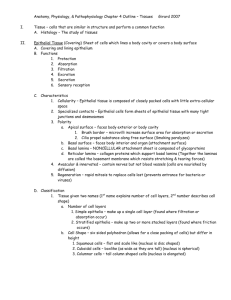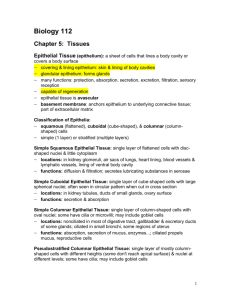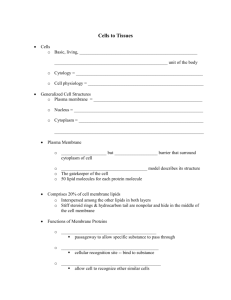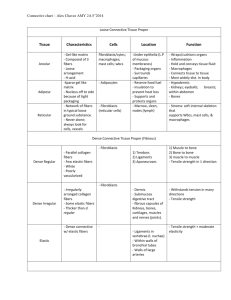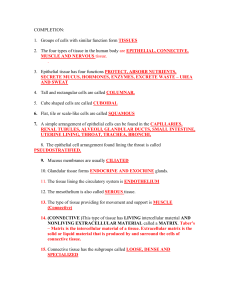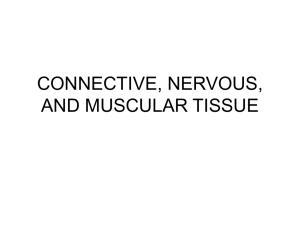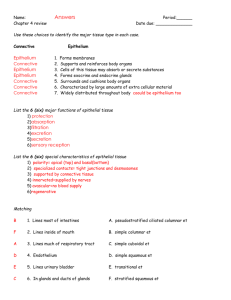CLOZE Notes Histology
advertisement
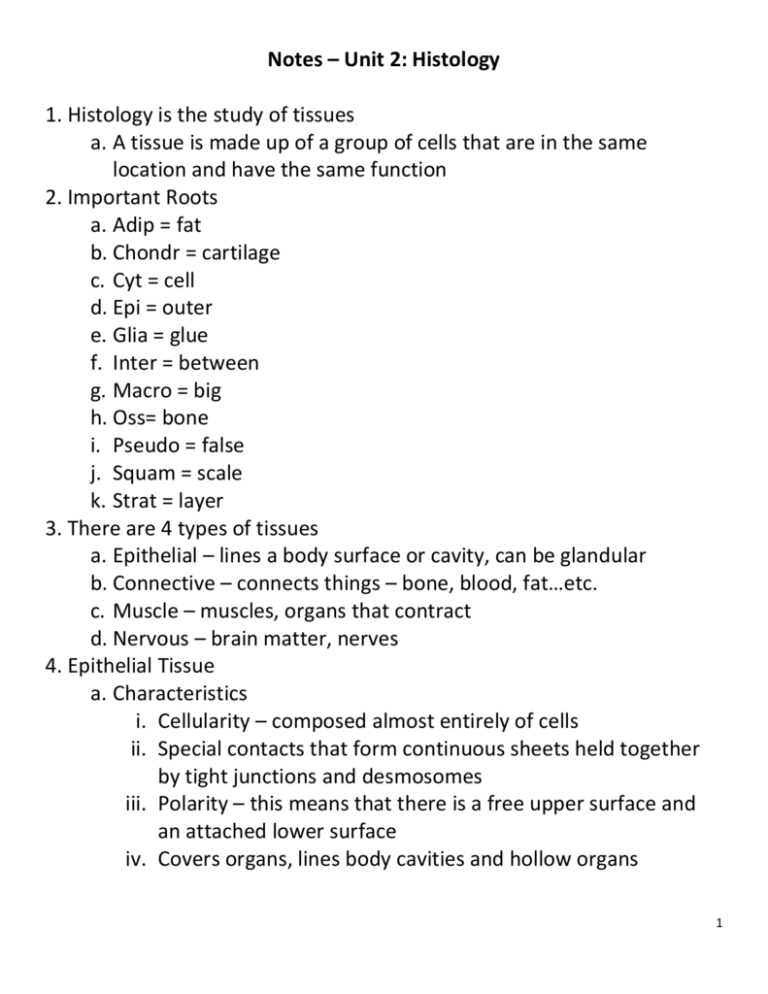
Notes – Unit 2: Histology 1. Histology is the study of tissues a. A tissue is made up of a group of cells that are in the same location and have the same function 2. Important Roots a. Adip = fat b. Chondr = cartilage c. Cyt = cell d. Epi = outer e. Glia = glue f. Inter = between g. Macro = big h. Oss= bone i. Pseudo = false j. Squam = scale k. Strat = layer 3. There are 4 types of tissues a. Epithelial – lines a body surface or cavity, can be glandular b. Connective – connects things – bone, blood, fat…etc. c. Muscle – muscles, organs that contract d. Nervous – brain matter, nerves 4. Epithelial Tissue a. Characteristics i. Cellularity – composed almost entirely of cells ii. Special contacts that form continuous sheets held together by tight junctions and desmosomes iii. Polarity – this means that there is a free upper surface and an attached lower surface iv. Covers organs, lines body cavities and hollow organs 1 v. Has a basement membrane – underside of the Epithelial Tissue that is non-living and anchored to the Connective Tissue vi. Avascular – no blood supply vii. Innervated – supplied by nerve fibers viii. Regenerative – can rapidly replace lost cells b. Functions of Epithelial Tissue i. Protection ii. Absorption iii. Secretion iv. Excretion v. Filtration vi. Sensory reception c. How Epithelial Tissue is categorized i. Number of Layers 1. Simple – one layer 2. Stratified – more than one layer 3. Pseudostratified – Single layer of cells, but the cells are at different heights and give the appearance of multiple layers ii. Shape of the cells 1. Squamous - flat 2. Cuboidal – cube-shaped 3. Columnar – column-shaped 4. Transitional – change shape according to contents of what it is lining d. There are 9 specific types of Epithelial Tissue i. Simple Squamous – functions in diffusion and filtration; discshaped nuclei; provide a slick, friction-reducing lining in the lymphatic and cardiovascular systems; present in the kidney 2 ii. iii. iv. v. vi. vii. viii. ix. glomeruli, lining of the heart, blood vessels and lymphatic vessels Simple Cuboidal – functions in secretion and absorption; nuclei shaped like spheres; found in the kidney tubules, ducts and secretory portions of small glands and the ovary surface Simple Columnar – oval-shaped nuclei, function in absorption and secretion 1. Non-Ciliated – line the digestive tract and gall bladder 2. Ciliated – line small bronchi, uterine tubes, some regions of the uterus a. Cilia – help move substances through internal passageways Pseudostratified Columnar – function in secretion and propulsion of mucous, present in the male sperm-carrying ducts (non-ciliated) and trachea (ciliated) Stratified Squamous – function in protection of underlying areas subjected to abrasion, forms the external part of the skin’s epidermis, linings of the esophagus, mouth and vagina Stratified Cuboidal – rare, found in some sweat and mammary glands Stratified Columnar – limited distribution in the body, found in the pharynx, male urethra and lining some glandular ducts, might find in transition areas between two types of epithelia Transitional – cells stretch to permit the distension of the urinary bladder, found in the urinary bladder, ureters and part of the urethra Glands - a gland is one or more cells that makes and secretes and aqueous fluid. Glands are classified by 1. Site of product release – endocrine or exocrine 2. Number of cells making the gland – unicellular or multicellular 3 3. Types of Glands a. Endocrine – ductless and make/ secrete hormones – secrete within the body b. Exocrine – more numerous than endocrine; secrete products onto body surfaces or into body cavities; types – mucous, sweat, oil, salivary i. Unicellular Exocrine Gland – Goblet Cell – makes Mucous ii. Multicellular Exocrine Glands have a duct and secreting unit 4. Glands can be classified by how they secrete their products a. Merocrine Glands secrete their products by exocytosis (pancreas, sweat, salivary glands) b. Holocrine Glands – secrete their products by the rupturing of gland cells (sebaceous glands) 5. Connective Tissue – found throughout the body; most abundant a. 4 Types of Connective Tissue i. Connective Tissue Proper ii. Cartilage iii. Bone iv. Blood b. Functions of Connective Tissue i. Binding and Support ii. Protection iii. Insulation iv. Transporation c. Characteristics of connective tissue 4 i. All originate from mesenchymal tissue during embryonic development ii. Vascularity iii. Non-living extracellular MATRIX – made of Ground Substance and Fibers iv. Cells are further apart compared to Epithelial cells d. 3 parts of Connective Tissue i. Ground Substance – unstructured material that fills the space between cells ii. Fibers – collagen, elastic, reticular iii. Cells – fibroblasts, chondroblasts, osteoblasts and hemopoeitic stem cells GROUND SUBSTANCE + FIBERS = MATRIX e. Ground Substance – made of interstitial fluid and adhesion proteins (fibronectin and lamnnin) f. Fibers i. Collagen – tough; provides tensile strength, make collagen, most common 1. Found in Dense CT ii. Elastic – long, thin fibers that allow for stretching, make Elastin iii. Reticular – branched collagenous fibers that form delicate networks 1. Most thin, made of collagen g. Cells Found In Connective Tissue i. Fibroblasts – CT Proper 1. Most common, star-shaped, make fibers ii. Chondroblasts – cartilage iii. Osteoblasts – bone iv. Hematopoietic Stem Cells – blood 5 v. White blood cells, plasma cells, macrophages and mast cells – all involved in Immune Responses vi. Mast Cells – large, usually near blood vessels vii. Macrophages – defense viii. Adipocyte – fat h. The 4 types of Connective Tissue i. Connective Tissue Proper – Loose and Dense 1. Loose CT – 3 types a. Areolar CT i. Gel-like matrix with all 3 connective tissue fibers ii. Fibroblasts, macrophages, mast cells, and some white blood cells iii. Wraps and cushions organs iv. Widely distributed throughout the body b. Adipose CT i. Matrix is similar to Areolar CT with closely packed adipoctyes ii. Reserves food stores, insulates against heat loss, supports and protects iii. Found under skin, around kidneys, within the abdomen and breasts iv. Local fat deposits serve nutrient needs of highly active organs c. Reticular CT i. Loose ground substance with reticular fibers ii. Forms a soft internal skeleton, or stroma, that supports other cells iii. Found in lymph nodes, bone marrow and the spleen 2. Dense CT – 2 types 6 a. Dense Regular i. Parallel collagen fibers with a few elastic fibers ii. Major cell type is fibroblasts iii. Attaches muscles to bone or to other muscles and bone to bone iv. Found in tendons and ligaments b. Dense Irregular i. Irregularly arranged collagen fibers with some elastic fibers ii. Main cell type is fibroblasts iii. Withstands tension in many directions providing structural strength iv. Found in the dermis, submucosa of the digestive tract, and fibrous organ capsules 3. Cartilage – 3 types a. Hyaline Cartilage i. Amorphous, firm matrix with imperceptible network of collagen fibers ii. Supports, reinforces, cushions and resists compression iii. Forms the costal cartilage – on your ribs iv. Found in the embryonic skeleton, ends of long bones, nose, trachea and larynx b. Elastic Cartilage i. Similar to hyaline cartilage but with more elastic fibers ii. Maintains shape and structure while allowing flexibility iii. Supports the external ear (pinna) and the epiglottis (covering of the windpipe c. Fibrocartilage 7 i. Matrix similar to hyaline cartilage but less firm with thick collagen fibers ii. Provides tensile strength and absorbs compression shock iii. Found in intervertebral discs, pubic symphysis and in discs of the knee joint 4. Bone (Osseus) Tissue a. Hard, calcified matrix with collagen fibers found in bone b. Osteocytes are well vascularized c. Supports, protects and provides levers for muscular action d. Stores calcium, minerals and fat e. Marrow inside of bones is the site of hemopoiesis 5. Blood – only liquid connective tissue a. Two parts – Formed Elements and Plasma b. Contained within blood vessels c. Functions in the transport of respiratory gases, nutrients and wastes 6. Nervous Tissue a. Branched Neurons with long cellular processes and support cells called Neuroglia b. Transmits electrical signals from sensory receptors to effectors c. Found in the brain, spinal cord, and peripheral nerves 7. Muscular Tissue a. 3 types of Muscular Tissue i. Skeletal 1. Long, cylindrical, multinucleated cells with obvious striations 2. Initiates and controls voluntary movement 3. Found in skeletal muscles that attach to bones or skin 8 ii. Cardiac 1. Branching, striated, uninucleated cells interlocking at intercalated discs 2. Propels blood into the circulation 3. Found in the walls of the heart 4. Involuntary iii. Smooth 1. Sheets of spindl-shaped cells with central nuclei and no striations 2. Propels substances along internal passageways 3. Found in the walls of hollow organs 4. Involuntary 8. Epithelial Membranes a. Cutaneous – skin b. Mucous – lines body cavities open to the exterior c. Serous – moist membranes found in closed ventral body cavity 9

